|
You can save images from the camera to a computer via Wi-Fi using EOS Utility (EOS software).
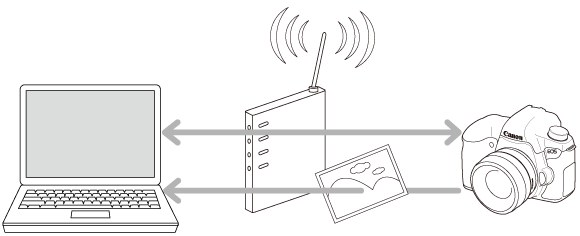
Step 1. Prepare Necessary Items
1. Check your computer environment.
To check if your computer supports connection to a camera via Wi-Fi, refer to the "Related information" section below.
2. Make sure that EOS Utility is installed on the computer.
IMPORTANT
Settings may be disabled when an older version of software is used. Install a version of EOS Utility that is compatible with this camera.
Step 2. Performing Basic Camera Settings
The following settings must be performed before the cameraâs Wi-Fi function is used.
1. Turn on the camera.
Set the camera's power switch to <ON>.
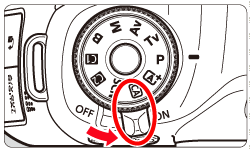
2. Press the <MENU> button to display the menu screen.
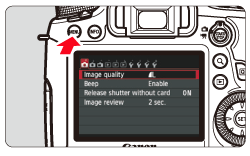
3. Press the <   > keys to select [Wi-Fi] under the [  ] tab, then press <  >.
4. Select [Enable], then press <  >. [Wi-Fi function] is now selectable.
REFERENCE
Set [Auto power off] under the [  ] tab to [Disable].
- If the auto power off takes effect during the wireless LAN connection, the wireless LAN function will turn off. It will be restored when the camera wakes up from the power off state.
5. Select [Wi-Fi function] under the [  ] tab, then press <  >.
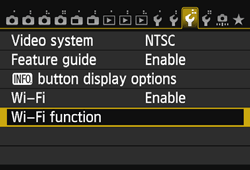
REFERENCE
When setting up Wi-Fi for the first time, a screen to register a nickname is displayed.
When the camera is connected to another device wirelessly, the nickname will be displayed on the device. Be sure to set a nickname as otherwise you cannot set the wireless functions.
Select [OK] and then enter a nickname. (Up to 16 characters can be entered.)
When you are finished, press the <MENU> button.
Select [OK] on the confirmation screen, then press <  >.
The nickname is registered, and [Wi-Fi function] screen will appear.
NOTE
Virtual Keyboard Operation
- Switching to other input areas
To switch between top and bottom input areas, press the <Q> button.
To move the cursor, press the Multi-controller's left/right keys in the top area.
In the bottom input area, press the Multi-controller to select characters and press <  > to enter them. You can check how many characters you have entered, and how many more can be entered, by referring to [*/*] on the upper right of the screen. If you make a mistake, press the <  > button to erase it. Press the <MENU> button to confirm what you have entered and exit. If a confirmation screen is displayed, select [OK] to exit.
Press the <INFO.> button to cancel text entry and exit. If a confirmation screen is displayed, select [OK] to exit.
6. The [Wi-Fi function] screen will be displayed.
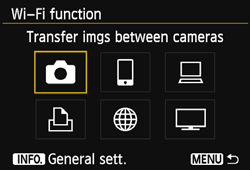
This concludes the basic camera settings.
Step 3. Connecting the Camera to the Computer
1. Select [  ], then press <  >.
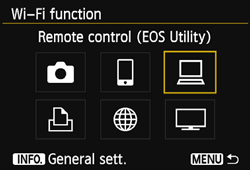
2. Select the Wireless LAN setup method, and connect to the access point using one of the following methods.
When Wi-Fi Protected Setup (WPS) is supported:
3A. Easy Connection via WPS (PBC Mode)
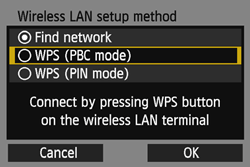
3B. Easy Connection via WPS (PIN Mode)
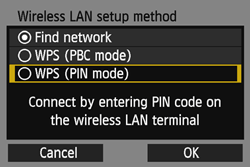
When WPS is not supported:
3C. Manual Connection by Searching Networks
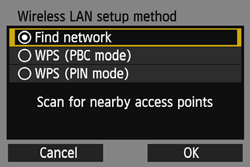
NOTE
- WPS (Wi-Fi Protected Setup) is a structure for simplifying settings when connecting one wireless LAN device to another.
-In pushbutton connection mode (PBC mode), the camera and the access point can be connected simply by pressing the WPS button on the access point.
-In PIN code connection mode (PIN mode), an 8-digit identification number specified on the camera is set at the access point to establish a connection.
- If you do not know if the access point you use is WPS-compatible, refer to the access point instruction manual or other documents.
- 3A. Easy Connection via WPS (PBC Mode)
IMPORTANT
If stealth functions of the access point are enabled, connection may be disabled. Deactivate stealth functions.
NOTE
Check the position of the WPS button on the access point in advance.
3A-1. Press the <  > key to select [WPS (PBC mode)], then press <  >.
- Select [OK] and press <
 > to go to the next screen. > to go to the next screen.
3A-2. Press the access pointâs WPS button.
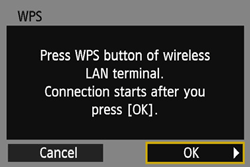
NOTE
For details about where the WPS button is located and how long to press it, refer to the access pointâs instruction manual.
3A-3. Select [OK] and press <  > to establish a connection with the access point.
- When a connection with the access point is established, the [IP address set.] screen is displayed.
3A-4. Press the <  > key to select [Auto setting], then press <  >.
- Select [OK] and press <
 > to go to the next screen. > to go to the next screen.
If you have completed the settings up to this point, proceed to Step 4.
- 3B. Easy Connection via WPS (PIN Mode)
IMPORTANT
If stealth functions of the access point are enabled, connection may be disabled. Deactivate stealth functions.
3B-1. Press the <  > key to select [WPS (PIN mode)], then press <  >.
- Select [OK] and press <
 > to go to the next screen. > to go to the next screen.
3B-2. At the access point, specify the 8-digit PIN code displayed on the cameraâs LCD monitor.
- After the PIN code is specified, select [OK] and press <
 >. >.
NOTE
For instructions on setting PIN codes at the access point, refer to the access pointâs instruction manual.
3B-3. Select [OK] and press <  > to establish a connection with the access point.
- When a connection with the access point is established, the [IP address set.] screen is displayed.
NOTE
It may take about one minute to establish a connection.
3B-4. Press the <  > key to select [Auto setting], then press <  >.
- Select [OK] and press <
 > to go to the next screen. > to go to the next screen.
If you have completed the settings up to this point, proceed to Step 4.
- 3C. Manual Connection by Searching Networks
3C-1. The access point's SSID, security method, and encryption key are all necessary for connection. Refer to the user guide included with your access point to look up information on SSID, Security method/encryption method, and security keys.
NOTE
- SSID-Numbers and letters are used to identify a specific existing access point. This is also called the "access point name" or "network name".
- Security method/encryption method is the method for encrypting data during wireless transmission.
- Encryption key (network key) is the key used when encrypting data during wireless transmission.
3C-2. Press the <  > key to select [Find network], then press <  >.
- Select [OK] and press <
 > to go to the next screen. > to go to the next screen.
3C-3. Press <  > to enable the selection of an access point, select the desired access point, then press <  > again.
- Select [OK] and press <
 > to go to the next screen. > to go to the next screen.
 Indicates whether the device is in infrastructure or ad hoc mode  An icon is displayed if the access point is encrypted  First nine characters of the SSID  Channel used
NOTE
- To configure settings for the access point manually, select [Enter connection] and press <
 >. Follow the procedures displayed to complete the settings. >. Follow the procedures displayed to complete the settings.
- To search for access points again, select [Search again] and press <
 >. >.
REFERENCE
This camera supports the following options for [Authentication] and [Encryption settings]. Therefore, the encryption used by the access point should be one of the following.
[Authentication]: Open system, Shared key, WPA-PSK, or WPA2-PSK
[Encryption settings]: WEP, TKIP, or AES
3C-4. Press the <  > key to select the format and the number of characters used for the key, then press <  >.
- Select [OK] and press <
 > to go to the next screen. > to go to the next screen.
REFERENCE
The [Key index] screen is displayed only if WEP encryption is used by the access point.
Select the key index number specified for the access point, then press <  >.
- Select [OK] and press <
 > to go to the screen shown in step 3C-4. > to go to the screen shown in step 3C-4.
3C-5. Enter the encryption key using the virtual keyboard.
- After a connection to the access point has been established, the [IP address set.] screen will be displayed.
3C-6. Press the <  > key to select [Auto setting], then press <  >.
- Select [OK] and press <
 > to go to the next screen. > to go to the next screen.
REFERENCE
Auto setting
- Configures the settings available in [Manual setting] automatically. However, this option can only be used in environments using DHCP servers, or access points or routers with DHCP server functionality, such that IP addresses and related settings are assigned and configured automatically. If an error is displayed even though the IP address and related settings should be automatically assigned and configured, select [Manual setting].
Manual setting
- If [Auto setting] results in an error, enter the IP address manually. Enter the IP address assigned to the camera when prompted for the IP address. Enter the [IP address], [Subnet mask], [Gateway], and [DNS address] on each screen as they are displayed.
- When entering numbers such as IP address or subnet mask, turn the <
 > dial to move the input position on the upper area and turn the < > dial to move the input position on the upper area and turn the <  > dial to select the number. Press < > dial to select the number. Press <  > to enter the selected number. > to enter the selected number.
- When you have finished entering information, press the <MENU> button. A confirmation screen is not displayed.
If you have completed the setting up to this point, proceed to Step 4.
4. Start EOS Utility.
- For Windows 7, click the [Start] button and select [All Programs] ->[Canon Utilities] ->[EOS Utility] ->[EOS Utility].
- For Windows 8, right-click the [Start] screen, then click [All Apps] on the bottom right side of the screen. On the [Apps] screen that is displayed, click [EOS Utility].
- For Windows 8.1, click [
 ] on the bottom left side of the [Start] screen. On the [Apps] screen that is displayed, click [EOS Utility]. ] on the bottom left side of the [Start] screen. On the [Apps] screen that is displayed, click [EOS Utility].
- For Windows 10, click the [Start] button, then click [All Apps] and then click [EOS Utility].
- For Mac OS X, click the [EOS Utility] icon in the Dock.
5. In EOS Utility, click [Pairing over Wi-Fi/LAN].
If a firewall-related message is displayed, select [Yes].
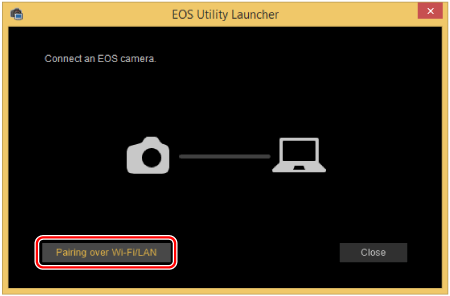
6. Press <  > to select [OK], then press the <  > button.
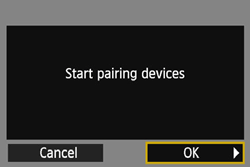
7. The following message is displayed.
"******" represents the last six digits of the MAC address of the camera to be connected.
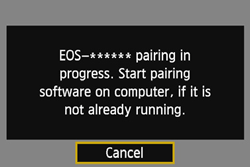
8. Detected cameras are listed. Click [Connect].
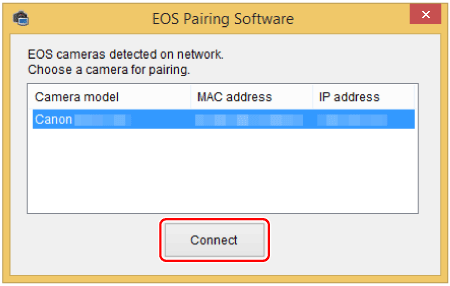
NOTE
- Cameras that have already been connected are not included in the list.
- If multiple cameras are displayed, identify the camera to connect to by its MAC address displayed on the cameraâs LCD monitor.
9. When the camera detects the computer on which you clicked [Connect] in step 8, the screen below is displayed.
Press the <  > key to select [OK], then press <  >.

10. Select [OK] and press <  > to save the settings.
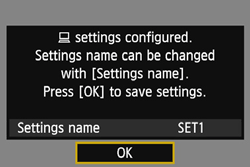
REFERENCE
To change the name of the settings, select [Settings name] and press <  >.
11. After the connection has been established, the [  Connection] screen is displayed. To end the connection, choose [Exit].
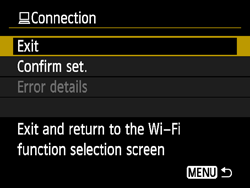
NOTE
- There is no need to complete pairing again if you will continue using a particular camera and computer together after pairing without changing the settings.
- If the camera screen auto-switches during EOS Utility operation procedures, display the menu by pressing the <MENU> button, and then select [Wi-Fi function] to go back to the [
 Connection] screen. Connection] screen.
Connecting the camera and the computer is now complete.
Step 4. Sending Images to the Computer
1. The main window of EOS Utility will be displayed, so click [Download Images to computer].
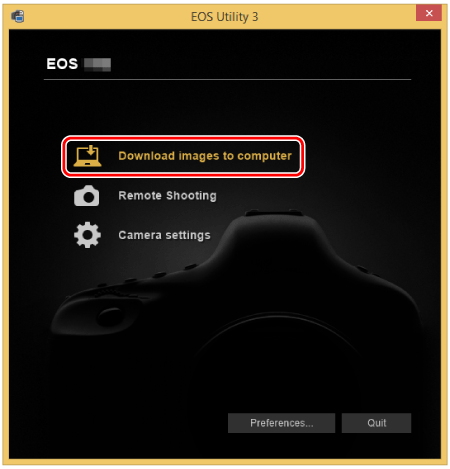
2. When the following window appears, click either (  ) to [Start automatic download] or (  ) to [Select and download] images.
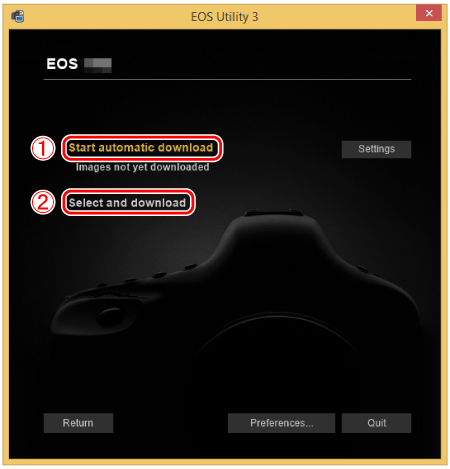
NOTE
By default, downloaded images are saved in the [Pictures] folder. You can change the save destination for images to download in [Preferences].
3. When [Select and download] is selected in step 2, the viewer window appears and the images in the memory card are displayed.
In the displayed list of images, checkmark the images to download and click [Download] (here, 4 images are selected).
If you selected [Start automatic download], proceed to step 5.
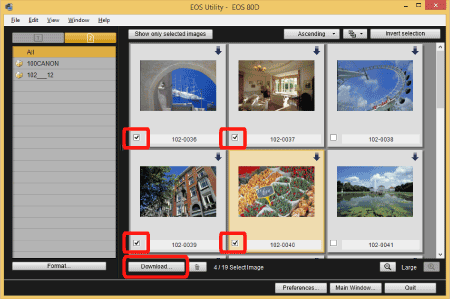
NOTE
- You can click [
 ] to change the thumbnail order. ] to change the thumbnail order.
- For movie files, the [
 ] icon appears on the top left of the image. ] icon appears on the top left of the image.
- You can click [
 ] in the upper right of the window to sort the images with various conditions and choose images you want to download. ] in the upper right of the window to sort the images with various conditions and choose images you want to download.
4. The [Download image] dialog box appears. To change the save destination, click [Destination Folder] and in the dialog box that appears, change the destination. Click [OK].
 Displays the save destination on the computer  Specify the save destination
5. The images are downloaded to your computer.

6. When all images have been downloaded, click the [Quit] button to close EOS Utility.
Downloading images is now complete.
|




 > keys to select [Wi-Fi] under the [
> keys to select [Wi-Fi] under the [  ] tab, then press <
] tab, then press <  >.
>.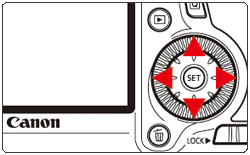
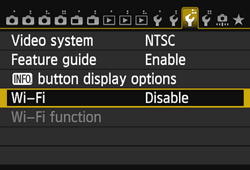
 >.
>.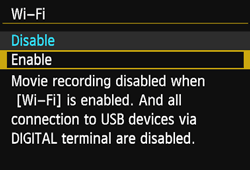
 ] tab, then press <
] tab, then press <  >.
>.

 ], then press <
], then press <  >.
>.



 > key to select [WPS (PBC mode)], then press <
> key to select [WPS (PBC mode)], then press <  >.
>.

 > to establish a connection with the access point.
> to establish a connection with the access point.
 > key to select [Auto setting], then press <
> key to select [Auto setting], then press <  >.
>.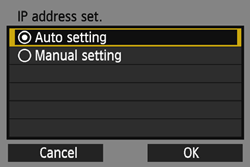
 > key to select [WPS (PIN mode)], then press <
> key to select [WPS (PIN mode)], then press <  >.
>.
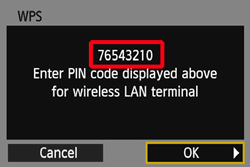
 > to establish a connection with the access point.
> to establish a connection with the access point.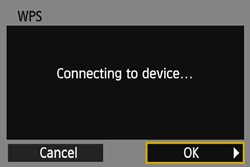
 > key to select [Auto setting], then press <
> key to select [Auto setting], then press <  >.
>.
 > key to select [Find network], then press <
> key to select [Find network], then press <  >.
>.
 > to enable the selection of an access point, select the desired access point, then press <
> to enable the selection of an access point, select the desired access point, then press <  > again.
> again.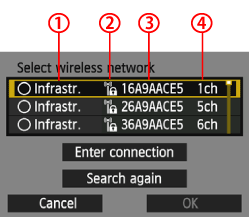
 Indicates whether the device is in infrastructure or ad hoc mode
Indicates whether the device is in infrastructure or ad hoc mode An icon is displayed if the access point is encrypted
An icon is displayed if the access point is encrypted First nine characters of the SSID
First nine characters of the SSID Channel used
Channel used > key to select the format and the number of characters used for the key, then press <
> key to select the format and the number of characters used for the key, then press <  >.
>.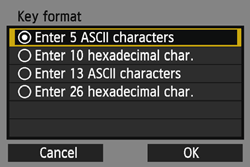
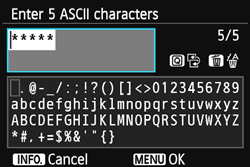
 > key to select [Auto setting], then press <
> key to select [Auto setting], then press <  >.
>.

 > to select [OK], then press the <
> to select [OK], then press the <  > button.
> button.


 > key to select [OK], then press <
> key to select [OK], then press <  >.
>.
 > to save the settings.
> to save the settings.
 Connection] screen is displayed. To end the connection, choose [Exit].
Connection] screen is displayed. To end the connection, choose [Exit].

 ) to [Start automatic download] or (
) to [Start automatic download] or (  ) to [Select and download] images.
) to [Select and download] images.

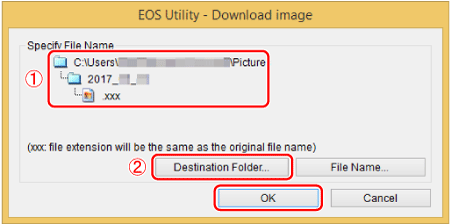
 Displays the save destination on the computer
Displays the save destination on the computer Specify the save destination
Specify the save destination

 ] tab to [Disable].
] tab to [Disable].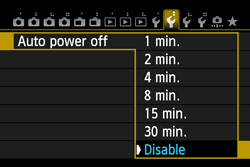

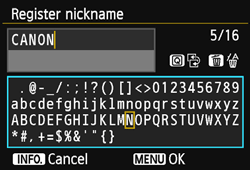
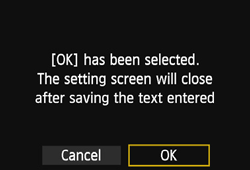
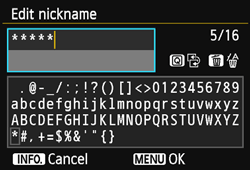
 > button to erase it.
> button to erase it.
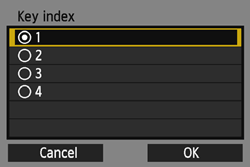
 > dial to move the input position on the upper area and turn the <
> dial to move the input position on the upper area and turn the <  > dial to select the number. Press <
> dial to select the number. Press < 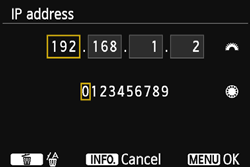
 ] on the bottom left side of the [Start] screen. On the [Apps] screen that is displayed, click [EOS Utility].
] on the bottom left side of the [Start] screen. On the [Apps] screen that is displayed, click [EOS Utility]. ] to change the thumbnail order.
] to change the thumbnail order. ] icon appears on the top left of the image.
] icon appears on the top left of the image. ] in the upper right of the window to sort the images with various conditions and choose images you want to download.
] in the upper right of the window to sort the images with various conditions and choose images you want to download.